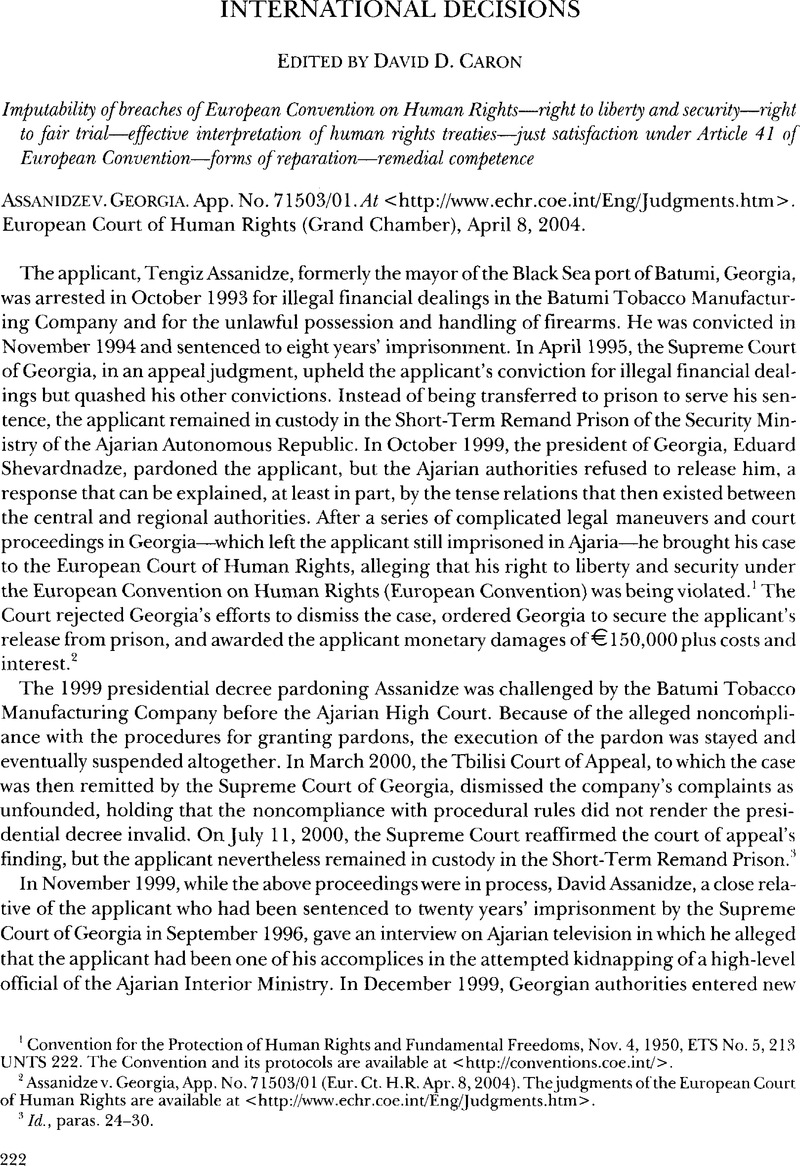Published online by Cambridge University Press: 27 February 2017

1 Convention for the Protection of Human Rights and Fundamental Freedoms, Nov. 4, 1950, ETS No. 5, 213 UNTS 222. The Convention and its protocols are available at <http://conventions.coe.int/>.
2 Assanidze v. Georgia, App. No. 71503/01 (Eur. Ct. H.R. Apr. 8, 2004). The judgments of the European Court of Human Rights are available at <http://www.echr.coe.int/Eng/Judgments.htm>.
3 Id., paras. 24-30.
4 Id., paras. 33-44.
5 Id., paras. 46-71.
6 Id., paras. 31,72-89.
7 Id., paras. 90-99.
8 Id., para. 3. The Court did not consider it necessary to focus on issues other than violations of Article 5(1) and 6(1) since the other alleged violations were closely interconnected to the breaches of those two provisions. Id., paras. 185-94.
9 Id., paras. 123-24.
10 Id., para. 89.
11 Id., paras. 126-31.
12 Id., paras. 132-36.
13 Id., paras. 137-38 (referring to previous jurisprudence such as Loizidou v. Turkey, Preliminary Objections, 310 Eur. Ct. H.R. (ser. A) (1995), discussed in Juliane Kokott & Beate Rudolf, Case Report: Loizidou v. Turkey, 90 AJIL 98 (1996), and Cyprus v. Turkey, 2001-IV Eur. Ct. H.R., discussed in Frank Hoffmeister, Case Report: Cyprus v. Turkey, 96 AJIL 445 (2002)).
14 Judgment, supra note 2, paras. 139-43.
15 See supra note 13.
16 Banković v. Belgium, Admissibility, App. No. 52207/99 (Eur. Ct. H.R. Dec. 12, 2001); see Alexandra Ruth & Mirja Trilsch, Banković v. Belgium, Admissibility, 97 AJIL 168 (2003).
17 Judgment, supra note 2, para. 144. Judge Loucaides, in his concurring opinion, seems to have to rejected Banković, at least implicitly, by pointing out that “a High Contracting Party is accountable under the Convention to everyone directly affected by any exercise of authority by such Party in any part of the world,” through “any kind of military or other State action on the part of the High Party concerned in any part of the world.” This position differs from the Court’s reaffirmation of Banković, where it emphasized that the Federal Republic of Yugoslavia was not a party to European Convention. On the inadequacies and deficiencies of the reasoning in Banković, see Orakhelashvili, Alexander, Restrictive Interpretation of Human Rights Treaties in the Recent Jurisprudence of the European Court of Human Rights, 14 Eur. J. Int’l L 529, 538–51 (2003)Google Scholar.
18 Judgment, supra note 2, para. 145.
19 Id., para. 146 (citations omitted) (discussing Ireland v. United Kingdom, 25 Eur. Ct. H.R. (ser. A) (1978)).
20 Id., paras. 147-50.
21 Id., paras. 152-54.
22 Id., paras. 158-62.
23 Id., paras. 164-66.
24 Id., para 170 (citations omitted).
23 Id., para. 171.
26 Id., para. 172.
27 Id., para. 182.
28 Id., para. 183.
29 Id., paras. 179-84.
30 Id., paras. 196-97.
31 Id., para. 198 (citations omitted).
32 Id., para. 199.
33 Id., paras. 199-201.
34 Id., paras. 202-03.
35 Wemhoff v. Germany, 7 Eur. Ct. H.R. (ser. A) at para. 8 (1968). As Lauterpacht suggests, that restrictive interpretation and the principle of effectiveness are mutually incompatible. Lauterpacht, Hersh, Restrictive Interpretation and Effectiveness in the Interpretation of Treaties, 1949 Brit. Y.B. Int’l L. 48, 50–51, 69 Google Scholar. Effectiveness as a canon of interpretation is found in Article 31(1) of the Vienna Convention on the Law of Treaties, opened for signature May 23, 1969, 1155 UNTS 331, which refers to the plain meaning of a treaty in the light of its object and purpose as the primary method of treaty interpretation. For an overview and analysis of the interpretation methods applicable to the European Convention, see Orakhelashvili, supra note 17, at 533-38.
36 Judgment, supra note 2, Joint Partly Diss. Op., Costa, Bratza, Thomassen, JJ., paras. 3-4.
37 Colder v. United Kingdom, 18 Eur. Ct. H.R. (ser. A) at 17-18 (1975).
38 Joint Partly Diss. Op., supra note 36, para. 5
39 Judgment, supra note 2, para. 198.
40 Id.
41 Cf. Orakhelashvili, Alexander, The European Convention on Human Rights and International Public Order, 2002 Cambridge Y.B. Eur. Legal Stud. 237, 266-67.Google Scholar
42 Id. at 262-64.
43 For an overview and analysis of the relevant practice of different tribunals, see Orakhelashvili, Alexander, Questions of International Judicial Jurisdiction in the LaGrand Case, 15 Leiden J. Int’l L. 105, 121–29 (2002)Google Scholar.
44 Judgment, supra note 2, Partly Concurring Op., Costa, J., paras. 3-5 (also indicating that restitution orders in previous cases were not absolutely mandatory).
45 Id., paras. 8-10.
46 Yöyler v. Turkey, App. No. 29673/95, paras. 122-24 (Eur. Ct. H.R.July 24, 2003).
47 Most significant in this context is the judgment by the International Court of Justice in Avena (Mex. v. U.S.) (Mar. 31, 2004), see Dinah, L. Shelton, Case Report: Case Concerning Avena and Other Mexican Nationals (Mexico v. United States), 98 AJIL 559 (2004)Google Scholar, where the Court ordered the United States to review and reconsider certain cases in its domestic legal system.
48 See Castillo-Páez v. Peru, Reparations, 43 Inter.-Am. Ct. H.R. (ser. C) (1998), 116 ILR 511; Suárez-Rosero v. Ecuador, Reparations, 44 Inter-Am. Ct. H.R. (ser. C) (1999), 118 ILR 111. On approaches and presumptions of international tribunals in finding the extent of moral, or nonpecuniary, damage or injury, see Orakhelashvili, Alexander, Peremptory Norms and the Reparation for Internationally Wrongful Acts, 2003 Baltic Y.B. Int’l L. 19, 44–48 (2003)Google Scholar. Moral injury is that which is not directly assessable in economic terms, such as the anguish or suffering caused to victims of human rights violations or their relatives. In the European Court’s jurisprudence, the term “non-pecuniary damage” is used to describe this phenomenon.
49 Judgment, supra note 2, para. 201.
50 See generally, Orakhelashvili, supra note 48, at 27-30, 39-40, 47-48.